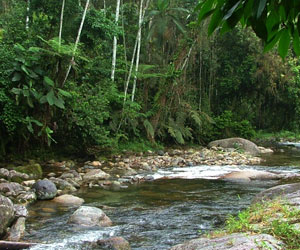Magazine | Voyages
Découvrir la Mata Atlântica au Brésil avec Rick Simpson

Cours d’eau dans la forêt Atlantique, dans le secteur d’Ubatuba (Brésil).
Photographie : Rick Simpson
Introduction
La Mata Atlântica, ou forêt Atlantique, s’étend le long de littoral atlantique du Brésil jusqu’à l’Uruguay, atteignant à l’intérieur des terres le nord-est de l’Argentine et le Paraguay oriental. Couvrant autrefois près de 1,5 million de km², sa superficie n’est plus que de 100 000 km² aujourd’hui, dont 2 % seulement sont restés intacts ! Malgré cette quasi-disparition, elle fait partie des biomes les plus riches du monde en terme de biodiversité.
Des parcs et réserves en protègent désormais plusieurs secteurs : c’est le cas du Parque Estadual da Serra do Mar (MSPE), créé en 1977 et dont la surface est de 315 390 hectares. Il est découpé en huit unités administratives (« núcleos »), comme celui de Picinguaba, à la limite des états de São Paulo et de Rio de Janeiro. Ce dernier protège 67% de la commune d’Ubatuba, l’un des meilleurs secteurs de la Mata Atlântica pour observer les oiseaux endémiques présents à basse altitude.
Nous avons interrogé Rick Simpson, un guide ornithologue confirmé (www.rick-simpson.com) connaissant très bien les oiseaux de la Mata Atlântica et l’un des responsables de l’Ubatuba Birdwaching Centre.
Abstract
The Atlantic Forest stretches from north-east Brazil south along the Brazilian Atlantic coastline just into coastal Uruguay, and inland into north-east Argentina and eastern Paraguay. Once covering an estimated 1,477,500 km2, centuries of deforestation have seen the Atlantic Forest become the second most threatened biome in the world after Madagascar. Today only 7% of the original forest area remains, an area of 100,000 km2, and only an estimated 2% is still primary forest. Despite the loss and habitat fragmentation, this ecoregion is still ranked in the top five of the world’s biodiversity hotspots.
With 315 thousand hectares, the Serra do Mar State Park is one of the biggest remaining areas of continuous Atlantic Forest. Its rich flora, fauna and traditional cultures make it a place of indescribable beauty. Its total area stretches from the border of São Paulo with Rio de Janeiro until the township of Itariri in the south of the State, passing along the entire coastline.
. Due to its enormous extension, it is divided into 8 administrative sections (« nucleus »). The nucleus of Picinguaba protects 67 % of the territory of Ubatuba : the area around this little coastal town is one of the best to acquaint oneself with the birds of the lowland Atlantic forest.
We interviewed Rick Simpson, a confirmed guide who knows the birds of the Mata Atlântica very well and one of the persons in charge of the Ubatuba Birdwaching Centre.
You can read the English version of the intervi in the last part of this article.
Poursuivez la lecture de cet article, en vous abonnant dès maintenant !
Découvrez les Archives d’Ornithomedia.com
Pour seulement 10,00 €TTC/an (ou 6,00 € les 6 mois)
Profitez de plusieurs centaines d’articles en accès illimité et sans aucun engagement.
Compléments
Découvrir les oiseaux de la forêt atlantique avec Rick Simpson
Rick Simpson organise des tours guidés pour découvrir les oiseaux de la forêt atlantique. Plus d’informations sont disponibles sur www.rick-simpson.com.
Son site web décrit aussi plusieurs bons spots du Sud-est du Brésil.
Ouvrages recommandés
- A Field Guide to the Birds of Brazil de Ber van Perlo
- A Photographic Guide to Birds of Southern Brazil de Clive Byers
- Brazil National Map (1er février 2011) de Michelin Editions des Voyages
Sources
- Le site web de la commune d’Ubatuba, avec des informations sur le noyau Picinguaba du Parque Estadual da Serra do Mar : www.ubatuba.com.br
- Le site web de l’Ubatuba Birdwatching Centre : www.ubwc.info
- Le site web du Gouvernement de São Paulo sur les différents « noyaux » du Parque Estadual da Serra do Mar : www.saopaulo.sp.gov.br/conhecasp/turismo_turismo-ecologico_nucleo-santa-virginia
- Parque estadual Intervales : http://www.vivabrazil.com/vivabrazil/parque_estadual_intervales.htm
- Le site web de la Fundação Florestal do Estado de São Paulo : www.fflorestal.sp.gov.br





Aucun commentaire sur ce sujet
Participer à la discussion !